
The idea of the Crown Jewels being stolen might seem like a movie.
Well, it’s not. They really were stolen thanks to one Irishman, Thomas Blood.
Born in County Meath in 1618, Blood came from a good family. His father was a prosperous blacksmith, and his grandfather was a Member of Parliament. That said, one might assume he might not get into trouble.
When the English Civil War broke out in 1642, Blood came to England to fight for Charles I, but when it became clear Cromwell was going to win, Blood had a change of heart and joined the Roundheads as a lieutenant.
In 1653 as a reward for his service, Cromwell appointed Blood a justice of the peace and gave him a large estate. When Charles II returned to the throne in 1660, Blood returned to Ireland with his wife and son. There, he attempted to seize Dublin Castle and take both Lord Ormonde and the Governor prisoner. The plan backfired, and he went to Holland. Despite being one of the most wanted men in England, he returned in 1670 under a new name, Ayloffe.
After another failed attempt to kidnap Lord Ormonde, Blood started to plan to steal the Crown Jewels – a task that would not be easy as it was in a basement protected by a large metal grille and The Keeper of the Jewels, Talbot Edwards, who happened to live above the basement.
One day in 1671, Blood disguised himself as a ‘parson’ as he went to see the jewels. He became friendly with Edwards, and the two became very close. Edwards was thrilled when ‘Parson Blood’ recommended a meeting between Edward’s daughter and Blood’s ‘wealthy nephew.’
On 9 May 1871, ‘Parson Blood’ arrived with his ‘nephew’ and two other men who expressed a desire to see the Crown Jewels. Edwards led the way, and once he unlocked where they were kept, Blood knocked him unconscious with a mallet and stabbed him with a sword.
Of course, Blood knew he couldn’t just carry the jewels out into plain sight. He flattened the crown with a mallet and stuffed it into a bag. The orb was stuffed down his pants. The sceptre would be more challenging to get away with as it was too long to go into a bag. So, Blood’s brother-in-law tried to saw it in half!
By then, Edwards regained consciousness and shouted, “Murder, treason!”
Blood and his accomplices dropped the sceptre and ran, but Blood didn’t make it far as he was arrested at The Tower’s iron grate. Once in custody, Blood refused to answer questions and repeatedly said, “I’ll answer to none, but the King himself.”
Blood was aware His Majesty had a reputation for liking bold scoundrels and thought he might be able to use his Irish charm to save his neck as he’d done several times before. Questioned by members of the Royal Family, The King was amused when Blood claimed the jewels were not worth the estimated £100,000 but rather only £6,000.
The King asked, “What if I should give you your life?”
To which Blood answered, “I would endeavour to deserve it, Sire!”
Blood was pardoned, much to the dismay of Lord Ormonde. On top of this, he was given Irish lands worth £500 a year. Blood became a familiar face around London and made frequent court appearances.
As for Edwards, he recovered and was rewarded by The King. He lived to be a ripe old age and shared his story with the visitors to The Tower.
For Blood, his luck ran out in 1679 when he quarrelled with his former patron, the Duke of Buckingham. The Duke demanded £10,000 for insulting remarks Blood made about his character. Blood became ill the next year and died at the age of 62. The Duke never got paid.
Since then, The Crown Jewels have never been stolen.

